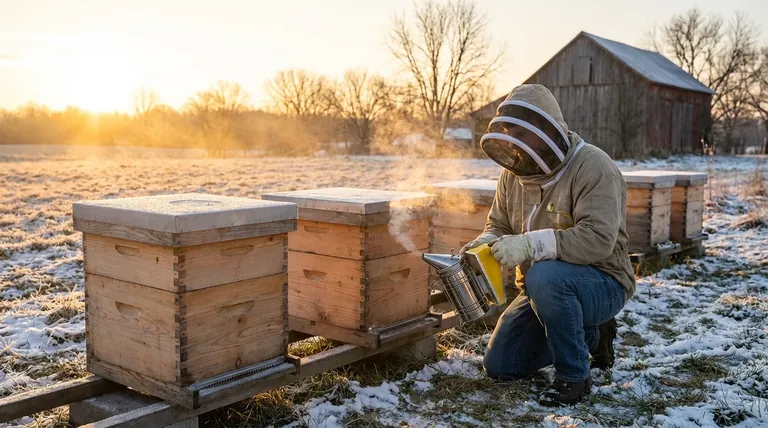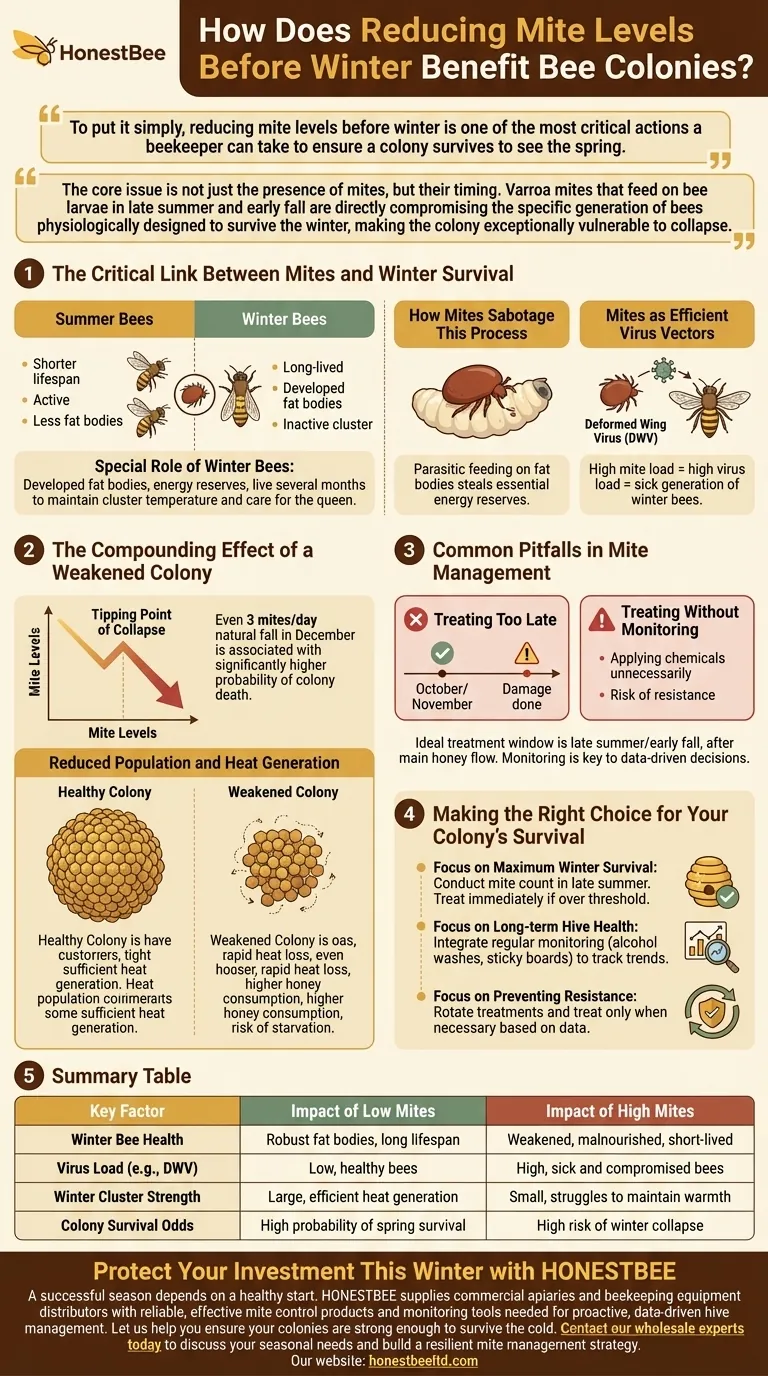To put it simply, reducing mite levels before winter is one of the most critical actions a beekeeper can take to ensure a colony survives to see the spring. Lowering the Varroa mite population before the cold sets in allows the colony to raise a final generation of healthy, long-lived "winter bees," which are essential for maintaining the cluster's temperature and caring for the queen until foraging can resume.
The core issue is not just the presence of mites, but their timing. Varroa mites that feed on bee larvae in late summer and early fall are directly compromising the specific generation of bees physiologically designed to survive the winter, making the colony exceptionally vulnerable to collapse.

The Critical Link Between Mites and Winter Survival
To understand why pre-winter mite control is so vital, we must first understand the unique biology of the bees that will carry the colony through the cold months.
The Special Role of "Winter Bees"
Unlike summer bees that live for only a few weeks, the last generation of bees raised in the fall are physiologically different. These "winter bees" have more developed fat bodies, which act as critical energy and protein reserves.
Their entire purpose is to live for several months, form a tight cluster around the queen to generate heat, and survive until the first pollen flows of spring.
How Mites Sabotage This Process
Varroa mites are parasitic, feeding on the fat bodies of both adult bees and developing larvae. When they feed on the larvae destined to become winter bees, they effectively steal their essential energy stores.
This leaves the resulting adult bees weakened, malnourished, and with a significantly shorter lifespan. They are simply not equipped to endure the long, cold winter.
Mites as Efficient Virus Vectors
The physical damage from feeding is only part of the problem. Varroa mites are notorious for transmitting a host of debilitating viruses, most notably Deformed Wing Virus (DWV).
A bee infected with DWV as it develops will be unhealthy and short-lived, even if its wings appear normal. A high mite load in the fall ensures a high virus load, creating a generation of winter bees that is sick from birth.
The Compounding Effect of a Weakened Colony
A colony entering winter with a weak, sick, and short-lived population faces a cascade of problems that are often impossible to overcome.
The Tipping Point of Collapse
Research shows a direct correlation between mite levels and winter losses. Even a seemingly low mite load can be fatal.
For example, a natural mite fall of just three mites per day in December is associated with a significantly higher probability of colony death. This demonstrates how a small-looking problem can quickly overwhelm a colony's defenses.
Reduced Population and Heat Generation
A healthy colony relies on a large population to form an insulating cluster and generate heat. When winter bees die off prematurely due to mites and viruses, the cluster shrinks.
A smaller cluster loses heat more rapidly and must work harder, consuming more honey stores just to stay warm. This can lead to starvation long before spring arrives.
Common Pitfalls in Mite Management
Effective mite control is about precision and timing. Simply applying a treatment is not enough; it must be done correctly to have the desired impact.
Treating Too Late
The most common mistake is waiting too long. The goal is to protect the larvae that are developing into winter bees.
If you wait until October or November to treat, the damage to that crucial generation has already been done. The ideal treatment window is often in the late summer or early fall, after the main honey flow.
Treating Without Monitoring
Applying treatments without first confirming that mite levels have crossed an economic threshold is counterproductive. It exposes the bees to chemicals unnecessarily, can harm larval development, and accelerates the mites' development of chemical resistance.
Monitoring your mite levels is the only way to make a data-driven, responsible treatment decision.
Making the Right Choice for Your Colony's Survival
Your approach to mite management should be strategic and timed to protect the bees that matter most for winter survival.
- If your primary focus is maximum winter survival: Conduct a mite count in late summer. If it exceeds the established threshold, apply an appropriate treatment immediately to ensure the next generation of brood is healthy.
- If your primary focus is long-term hive health: Integrate regular mite monitoring (such as alcohol washes or sticky boards) into your routine. This allows you to track population trends and act proactively.
- If your primary focus is preventing treatment resistance: Rotate different types of approved treatments and, most importantly, treat only when your monitoring data shows it is absolutely necessary.
Proactive mite management in late summer is the single most important investment you can make in your colony's future.
Summary Table:
| Key Factor | Impact of Low Mites | Impact of High Mites |
|---|---|---|
| Winter Bee Health | Robust fat bodies, long lifespan | Weakened, malnourished, short-lived |
| Virus Load (e.g., DWV) | Low, healthy bees | High, sick and compromised bees |
| Winter Cluster Strength | Large, efficient heat generation | Small, struggles to maintain warmth |
| Colony Survival Odds | High probability of spring survival | High risk of winter collapse |
Protect Your Investment This Winter with HONESTBEE
A successful season depends on a healthy start. Don't let Varroa mites compromise your winter bees and lead to costly spring losses. HONESTBEE supplies commercial apiaries and beekeeping equipment distributors with the reliable, effective mite control products and monitoring tools needed for proactive, data-driven hive management.
Let us help you ensure your colonies are strong enough to survive the cold. Contact our wholesale experts today to discuss your seasonal needs and build a resilient mite management strategy.
Visual Guide

Related Products
- Professional Bee Smoker with Elongated Spout and Durable Bellows for Beekeeping
- Ventilated Adult Beekeeping Helmet Hat for Beekeepers
- Professional Multi-Function Stainless Steel Hive Tool
- Wholesales Dadant Size Wooden Bee Hives for Beekeeping
- Long Langstroth Style Horizontal Top Bar Hive for Wholesale
People Also Ask
- Does smoke affect bees? Uncover the Secret to Calming Your Hive Safely
- What are the differences between stainless steel and galvanized steel bee smokers? Choose the Right Smoker for Your Apiary
- What is a bee smoker and how does it work? Master the Tool for Calm, Safe Hive Inspections
- How does smoke from a bee smoker affect honeybees? The Science Behind a Calm Hive
- Why is smoke used when harvesting honey? Safely Manage Your Hive with Proven Techniques



















